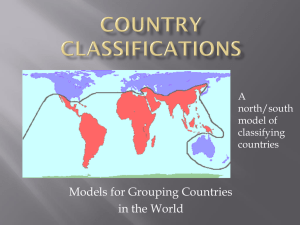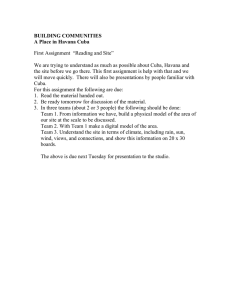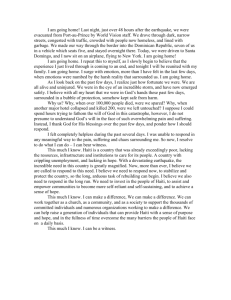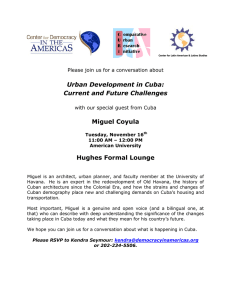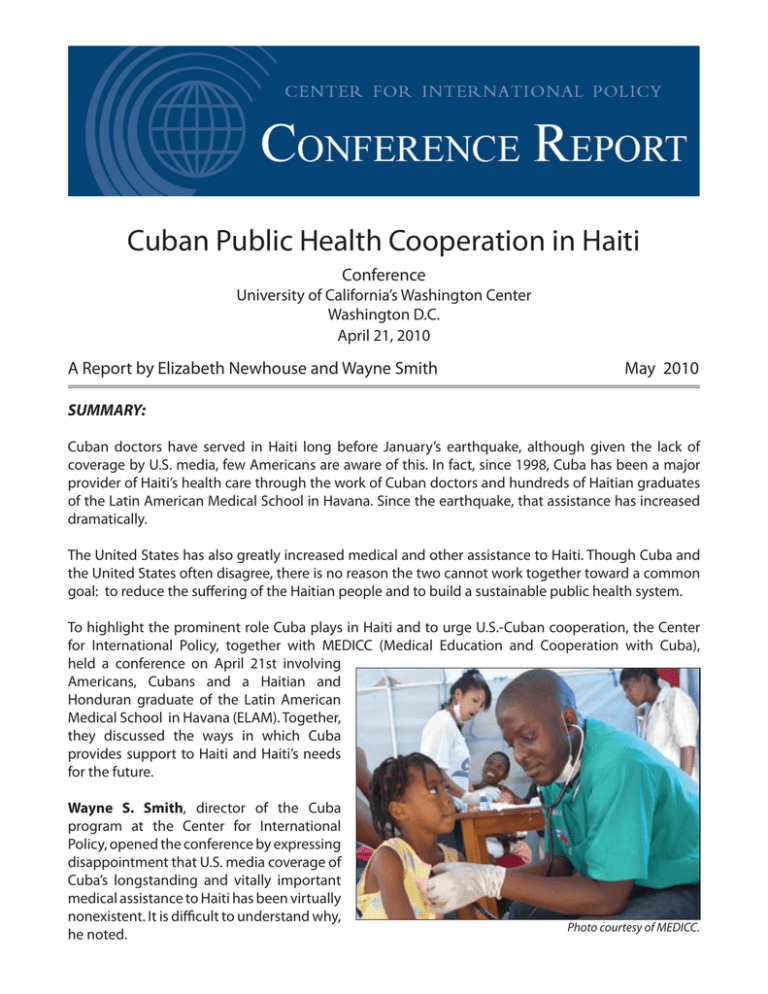
Cuban Public Health Cooperation in Haiti
Conference
University of California’s Washington Center
Washington D.C.
April 21, 2010
A Report by Elizabeth Newhouse and Wayne Smith
May 2010
SUMMARY:
Cuban doctors have served in Haiti long before January’s earthquake, although given the lack of
coverage by U.S. media, few Americans are aware of this. In fact, since 1998, Cuba has been a major
provider of Haiti’s health care through the work of Cuban doctors and hundreds of Haitian graduates
of the Latin American Medical School in Havana. Since the earthquake, that assistance has increased
dramatically.
The United States has also greatly increased medical and other assistance to Haiti. Though Cuba and
the United States often disagree, there is no reason the two cannot work together toward a common
goal: to reduce the suffering of the Haitian people and to build a sustainable public health system.
To highlight the prominent role Cuba plays in Haiti and to urge U.S.-Cuban cooperation, the Center
for International Policy, together with MEDICC (Medical Education and Cooperation with Cuba),
held a conference on April 21st involving
Americans, Cubans and a Haitian and
Honduran graduate of the Latin American
Medical School in Havana (ELAM). Together,
they discussed the ways in which Cuba
provides support to Haiti and Haiti’s needs
for the future.
Wayne S. Smith, director of the Cuba
program at the Center for International
Policy, opened the conference by expressing
disappointment that U.S. media coverage of
Cuba’s longstanding and vitally important
medical assistance to Haiti has been virtually
nonexistent. It is difficult to understand why,
he noted.
Photo courtesy of MEDICC.
Conference Report
Center for International Policy
DEBT TO HAITI
The first panelist, Ambassador Jorge Bolaños, is a distinguished Cuban diplomat and chief of the
Cuban Interests Section in Washington, DC. Before his current assignment, the ambassador held posts
in Cuba’s foreign ministry and as emissary to many countries, including the United Kingdom and
Brazil.
Bolaños began his remarks by pointing out that although Haiti was the first country in the Americas
to achieve independence (which occurred in 1804), today it is the poorest country in the Western
Hemisphere. Later it supported other Latin American revolutions, leaving a number of countries in its
debt. It deserves the full support of the international community. The January 12, 2010 earthquake
killed 230,000 people, a catastrophic number that in a country the size of China would be equivalent
to 30 million deaths.
Cuba’s involvement in Haiti did not begin with the earthquake, Bolaños noted. Indeed, some 400 Cuban
doctors have served consistently in Haiti since 1998. In the first 72 hours after the quake, they were
among the first responders. Since then, Cuban medical teams have seen 263,000 patients, performed
7,400 surgeries and 1,600 deliveries, given 100,000 vaccinations, and helped 75,000 children with
social-psychological therapy in 127 communities around Haiti. The Cubans have treated many more
patients than any other foreign medical team.
In conjunction with the Haitian government, Bolivia, Brazil and Cuba now plan to rebuild the Haitian
health care system—with hospitals, polyclinics and medical schools—at a cost of $600 million. Brazil
has already contributed significant funds and other countries are stepping up to the plate. Bolaños
hopes that the United States, Canada and other developed countries will also participate. Generosity,
political will and unity, as well as respect for Haitian sovereignty and independence, are critical to the
success of new health care infrastructure.
PAHO’S ROLE AND U.S. TALKS WITH CUBA
The next panelist, Dr. Juan Manuel Sotelo, a Peruvian with the Pan-American Health Organization
(PAHO), noted that PAHO’s members include all countries of the Americas, as well as the Netherlands,
France and England, which hold territories in the hemisphere. Cuba is a longtime member. PAHO
participates in all United Nations health groups as well as in the Organization of American States.
PAHO has been working in Haiti since the early 1950s and has now taken on the major challenge of
assessing needs and coordinating some 800 international institutions in the health field. Its activities
focus on mental health, drug supplies, radiology, disease (especially malaria) prevention and water
and sanitation. UN countries, Dr. Sotelo noted, have sent enormous sums of money to Haiti over the
years—some $9.9 billion.
From the floor, John McAuliff of the Fund for Reconciliation and Development noted that he has read
reports of meetings between Cuba and the United States about cooperating in Haiti, but has seen
very little discussion of what was discussed. Ambassador Bolanos acknowledged that three rounds
of talks have occurred and another is planned. He declined to elaborate further, except to say that no
agreement has been reached. Cuba has sent proposals to the United States, with the approval of the
2
Conference Report
Center for International Policy
Haitians, and has permitted U.S. planes delivering food and medicine to Haiti to overfly Cuba. Cuba, he
said, is very willing to cooperate with the United States, as it is with any country.
Also from the floor, James Early of the Smithsonian Institution made the point that it is important Haiti
not become the focus of competitive attention. Statistical measurements of what is happening now
are not enough. It is the institution building that matters. Early asked: Money and people are pouring
in now, but to what end? What training is being done for the future? What institutions will be left?
Another conference attendee expressed outrage at the lack of international media coverage of Cuba’s
role in Haiti. And an official from the Norwegian embassy spoke up to say that Norway has supported
Cuba’s medical efforts in Haiti and has been very pleased with the experience. He also commented on
Cuba’s effective emergency preparedness system and asked whether Cuba is doing anything to help
Haitians prepare for future disasters. In reply, Ambassador Bolanos cited the trips CIP has made with
officials from the U.S. Gulf Coast to look at the Cuban system. “But what we do is difficult to replicate in
Haiti and elsewhere,” he noted.
MEDICC, MAINTAINING U.S.-CUBAN TIES IN HEALTH
The second panel brought officials of MEDICC and Global Links together with graduates of Cuba’s
Latin American Medical School (ELAM) to discuss their work in Haiti. Dr. Peter G. Bourne, MEDICC’s
chairman, said that over the past 15 years his organization has served as the major bridge between
Cuban and U.S. medical communities and has thus maintained stronger bilateral ties in the health field
than any other organization.
MEDICC grew out of a mid-1990s study led by Gail A. Reed on the impact of the U.S. embargo on Cuban
health care. The report, published by the American Association for World Health, appeared in three
languages and received widespread attention at the UN and in debates leading to the Congressional
lifting of the ban on food sales to Cuba. Over the years, MEDICC has taken groups of American medical
educators to Cuba to look at the system. They were highly impressed by the quality of primary care,
Dr. Bourne said, and felt it would be a great learning opportunity for U.S. medical students. In 1997
MEDICC set up an electives program to place American medical and public health students with
Cuban family physicians, especially in rural areas. From then until 2004, when the Bush administration
banned nearly all forms of student travel to Cuba, over 1,500 students from 140 U.S. medical schools
participated. MEDICC intended to make this a two-way exchange, but the U.S. government placed too
many obstacles on Cuban students to make a successful exchange feasible.
Today, MEDICC continues to work with health professionals and policymakers traveling to see the
Cuban health system. MEDICC also produced the film SALUD! and publishes MEDICC Review (www.
medicc.org/mediccreview), the only English-language peer-reviewed journal with contributions from
Cuban health professionals. Since the founding of Cuba’s Latin American Medical School in 1998,
MEDICC has supported students and graduates from many countries, including the U.S., to fulfill their
commitment to work in underserved areas once back home. The organization has also developed
Community Partnerships for Health Equity in two California cities, which invites teams of community
health leaders to see Cuba’s health system in practice and consider what lessons might be applied
to their own minority and low-income areas. MEDICC is now seeking to expand this very successful
program to other U.S. cities, Dr. Bourne noted.
3
Conference Report
Center for International Policy
DOES IT TAKE AN EARTHQUAKE?
Gail A. Reed, international director of MEDICC, was the next panelist, and she posed the question:
Does it take an earthquake to support real transformation and development in Haiti and to bring
about collaboration? Right now some 10,000 NGOs are there working independently. How can we
bring to bear such transformation, showing respect for the Haitian government? Rather than think
geopolitically, Reed urged we think in population health terms—globally 1.3 billion people have no
health care, and there is a shortage of 4.2 million health workers. Haiti is a microcosm of this enormous
problem.
Before the earthquake, Haiti’s health and education statistics were already dire. With a population
roughly the same as Cuba’s, Haiti had 54 infant deaths per 1,000 births to Cuba’s 4.9 and Latin America/
Caribbean’s 18.7; its life expectancy was 61 years to Cuba’s 79 and Latin America/Caribbean’s 73.5; its
adult literacy rate 62 percent compared to Cuba’s 99.8 percent and 91.1 percent in Latin America and
the Caribbean.
Reed pointed out that Cuba can greatly contribute to transforming Haiti’s health care due to its
experience in disaster medicine and recovery (the UN has designated it as regional disaster preparedness
hub), its 12 years of sustained involvement in Haiti, with more than 3,000 medical professionals sent
since 1998, and the medical resources it already has in place. Furthermore, Cuba’s own public health
system, focusing on primary care, is a prime model of what can be done with limited resources.
In addition to its impressive work in international disaster relief, now with the specialized Henry
Reeve Emergency Medical Contingent that deploys on 72-hours notice, Cuba has sent 134,849 health
professionals, since 1963, to 108 countries to work in poor and remote areas. As of a year ago, Reed
said, nearly 40,000 Cubans were serving two-year commitments in 74 countries. This year, before
the earthquake, there were already 348 Cubans staffing public health centers and hospitals in 127
communities throughout the country.
Most important to building the sustainability of its global health programs, Cuba founded the Latin
American Medical School in 1999 to train public service doctors from underserved and indigenous
communities around the world. Today it is the world’s largest and most ambitious medical school with
9,462 students (51 percent of them women) from 100 countries, including the United States. Their
training is geared to the needs of their individual countries, and graduates commit to returning to
work in their communities, often replacing Cuban doctors.
Approximately 550 Haitians have graduated from ELAM and roughly the same number are currently
enrolled. Although 84 percent of the graduates have returned to Haiti, the government does not have
the resources to pay public health salaries, which would cost only $500 a month, or $6,000 a year, per
doctor. “Some of the finances mobilized must get to these young people,” urged Reed. “Can’t [they]
receive salaries from the billions raised for hurricane relief?”
The next speaker, Conner Gorry, senior editor of MEDICC Review, had just returned from a month in
Haiti covering the Cuban health teams and was very inspired by their work under the most wrenching
conditions. The Haiti earthquake was the Henry Reeve Emergency Contingent‘s tenth mission in and
4
Conference Report
Center for International Policy
outside the hemisphere since its founding in 2005. Its teams were among the first responders, providing
emergency services and setting up field hospitals within 24 hours of the earthquake. They called for
ELAM graduates around the world to join them, and more than 600 did, including some 400 Haitians,
bringing the contingent to 1,500 health workers. The agile and innovative teams go into remote areas
to assess needs, and they provide a wide range of services, including vital epidemic prevention.
BEYOND THE EMERGENCY
Now Haiti is out of the emergency phase, Gorry continued, and the needs have changed. By mid-March
most international medical teams had started to leave the country. Cuba has folded its emergency teams
into a longer term effort to staff Haiti’s public health facilities, with most members of the contingent
opting to remain for a year or longer. Rehabilitation services have been urgently needed in post-quake
Haiti, and Cuba has established 20 clinics and has plans to set up 10 more by the year’s end. For most
Haitians, this is the first time they have had access to any form of rehabilitation.
Cuban health services are free, something new for most Haitians who are used to paying for services,
medicines and supplies. Another Cuban innovation is psychological therapy for the Haitians, especially
children and teens traumatized by the quake. More than 100,000 young people throughout the
country have participated. Dance performances and other activities run by Cuba’s Martha Machado
artists brigade help everyone cope. Cuba also takes part in multilateral collaborative efforts, such as
an ongoing mobile vaccination drive with PAHO and the Haitian Ministry of Health, first established in
October 2009 in Gonaive department.
The Cuban goal is nothing less than the rehabilitation of Haiti’s public health system, said Gorry. On
March 27th, Cubans signed a trilateral agreement with Haiti and Brazil, which includes a commitment of
$80 million from Brazil to help rebuild and to establish a national epidemiological surveillance network.
Cuba will provide medical services and staff training. A key aspect of the agreement is the integration
of Cuba educated Haitian doctors into the process. Haiti is very proud of its history, language and
culture, Gorry pointed out, and it is critical that Haitians be at the forefront of building the new public
health system.
LATIN AMERICAN MEDICAL SCHOOL’S CONTRIBUTIONS
Dr. Luther Castillo, a graduate of ELAM and a Garifuna, an indigenous people that make up 12
percent of Hondurans, followed Conner Gorry. While many Garifuna now study at ELAM, there were
no Garifuna doctors before the school’s existence. Thanks to ELAM the “dreams of an indigenous,
discriminated-against people can become a reality,” Castillo said. Castillo was instrumental in building
the first Garifuna hospital in Honduras, which opened in 2007 and has since offered over 378,000 free
consultations.
Dr. Castillo spoke of the contributions of ELAM graduates to the Haiti disaster relief. More than
600 signed up immediately with 65 percent willing to stay a year or more. Moreover, because they
often come from the poorest areas, it was easy for them to adapt to the Haitian reality, though it is a
challenge to practice medicine with so few resources. In April, some 250 additional ELAM graduates
will be arriving from 28 countries to help Haitian doctors build a health system. Castillo feels there is
much to be learned from the Haitians. Their strength and survivability given what they have endured
5
Conference Report
Center for International Policy
through history is remarkable. He believes Haiti could become a model for health care in developing
countries.
Joining the panel by conference call was Dr. Patrick Dely, a Haitian graduate of ELAM now working
in Haiti. He had been in Cuba doing graduate studies and returned to Haiti immediately after the
earthquake with the Henry Reeve Contingent. In response to a question about where in Haiti ELAM
Haitian graduates are working, he said that ELAM has graduated five classes overall and about 120
Haitian graduates from each of the first two classes were employed by the Ministry of Health around
Haiti. Now, however, employment is a serious problem as there are no funds to pay anyone. Some
doctors are working privately, some not at all, while others have moved to other professions. After the
earthquake, all in-country graduates rushed to volunteer with the Henry Reeve team and served in
hospitals, clinics, resettlement camps and wherever else needed.
Like Luther Castillo, Patrick Dely feels enormous gratitude for the opportunities given him by ELAM
and a strong commitment to serving his people, of whom nearly half over the age of 15 are illiterate.
He says ELAM doctors are determined to build the public health system. “We are the most important
group of Haitian doctors in the country,” he noted, “And we will be the pillar of whatever health system
develops.”
In his own hometown, St. Michel de l’Attalye (pop. 140,000), there were no schools and young people
had few options except to go to the Dominican Republic to cut cane. Now, Dr. Dely supports a very
ambitious project: an educational complex that would take a child from primary to technical school.
Until that is built, he has set up a rudimentary primary school that holds classes for 122 children; more
classes will be added each year. Since the children often come to school hungry, Dr. Dely is also trying
to establish a nutritional program. He also hopes to open a hospital.
MAKING USE OF SURPLUS U.S. MEDICAL SUPPLIES
The final panelist, Kathleen G. Hower, Global Links’ co-founder and executive director, described how
the organization works in partnership with PAHO and national and local health ministries to deliver U.S.
surplus medical supplies and equipment to nine countries in the hemisphere, including Cuba and Haiti.
Since 1989, Global Links has delivered 382 sea containers of materials worth $165 million. Bridging the
gap between need and surplus, her organization works with PAHO and the host countries to identify
need and then deliver appropriate, valuable medical materials otherwise destined for U.S. landfills.
These “recovered” materials allow hospitals to offer improved patient care, cut down on infection and
disease, and employ more sophisticated diagnostic and surgical techniques. New furnishings and
paint improve a hospital’s environment and boost morale of patients and staff. Another Global Links
program delivers high quality surgical sutures internationally, often improving surgical outcomes and
a patient’s chance of survival.
In Haiti, Global Links has supported the Albert Schweitzer Hospital for many years and is now working
with MEDICC, PAHO and the country’s public health system to deliver 15 large shipments of medical
aid over the next 18 to 23 months. These shipments will support the work of young Haitian doctors
educated at Havana’s ELAM.
In 1994, after the fall of the Soviet Union put Cuba’s economy into freefall and seriously threatened
its public health advances, Global Links, at the request of PAHO, began a medical aid program that
continues to this day. By the end of this year, the organization will have delivered 100 container
6
Conference Report
Center for International Policy
shipments of aid. In 2008 the island was devastated by hurricanes Gustav and Ike, causing over $5
billion in damages across the country. Global Links began a program of disaster relief, sending some
22 shipments to four of the most affected provinces.
Hower noted that the relationship with Cuba has expanded to include other collaborative efforts, such
as providing journals and medical books for the National Oncology Program and equipment for the
National Institute for Nephrology. Global Links has also worked to develop cross-sharing between
Cuban and U.S. medical professionals, most recently hosting the Cuban pediatric transplant team
for a week-long visit to Pittsburgh’s world-renowned Starzl Transplantation Institute and Pittsburgh
Children’s Hospital.
FINAL QUESTION, COMMENT AND A CONTRIBUTION
In response to a question about whether health is a constitutional right in Cuba, Gail Reed said not
only is it a right, but that Cubans have been better at putting it into practice than any other country.
Even with 40,000 doctors serving abroad (paid for by the host country or a third country), Cuba still
has 37,000 doctors practicing in Cuba, one of the world’s highest numbers per capita. This has led to a
restructuring of primary care, basing it in communities.
Jorge A. Lawton, who works with the Haitian Alliance in Atlanta, an association of the Haitian diaspora,
made the point that Haitians must own the process of rebuilding their public health system, as they
alone appreciate their history and culture and speak Creole. However, they lack an indigenous capacity
and badly need training. The diaspora must take part: Can there be a reversal from brain drain to brain
gain?
The conference concluded with MEDICC’s Peter Bourne and Gail Reed presenting a check for $50,000 to
Global Links, an example of multilateral cooperation in the critical quest to strengthen global health.
The Center for International Policy wishes to express its appreciation
to the Christopher Reynolds Foundation for its generous support,
without which neither the conference on April 21 nor this report
would have been possible.
Mission Statement: The Center is a nonprofit
educational and research organization whose
mission is to promote a U.S. foreign policy
based on international cooperation, demilitarization and respect for human rights.
1717 Massachusetts Avenue, NW
Washington, DC 20036
Tel: 202.232.3317
Fax: 202.232.3440
cip@ciponline.org
www.ciponline.org
© Copyright 2010 by the Center for International Policy. All rights reserved. Any material herein
may be quoted without permission, with credit
to the Center for International Policy.
7

